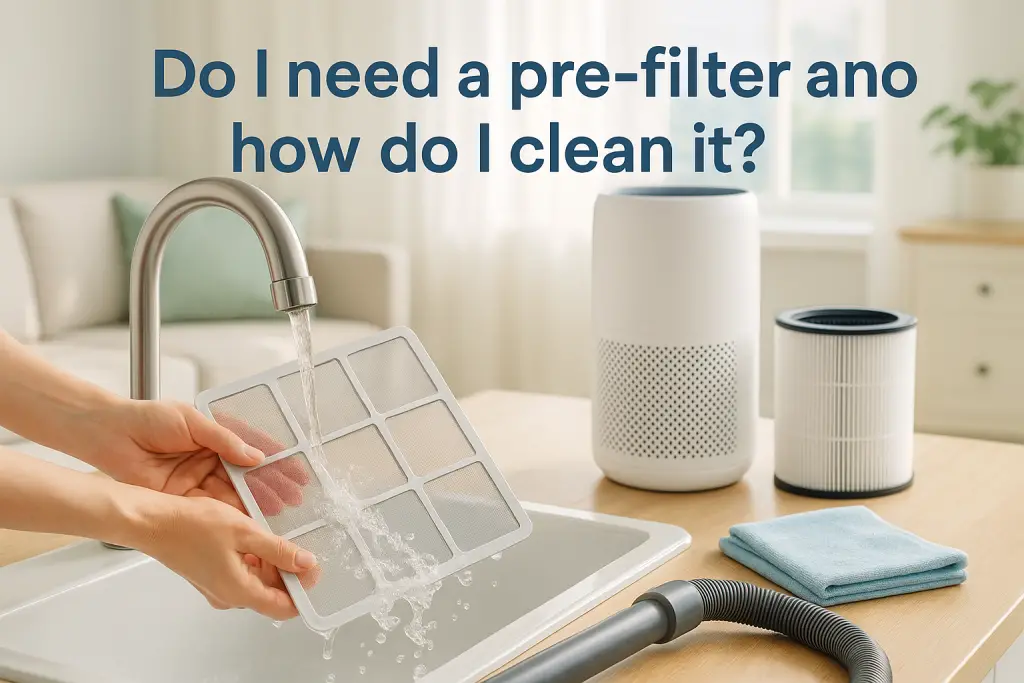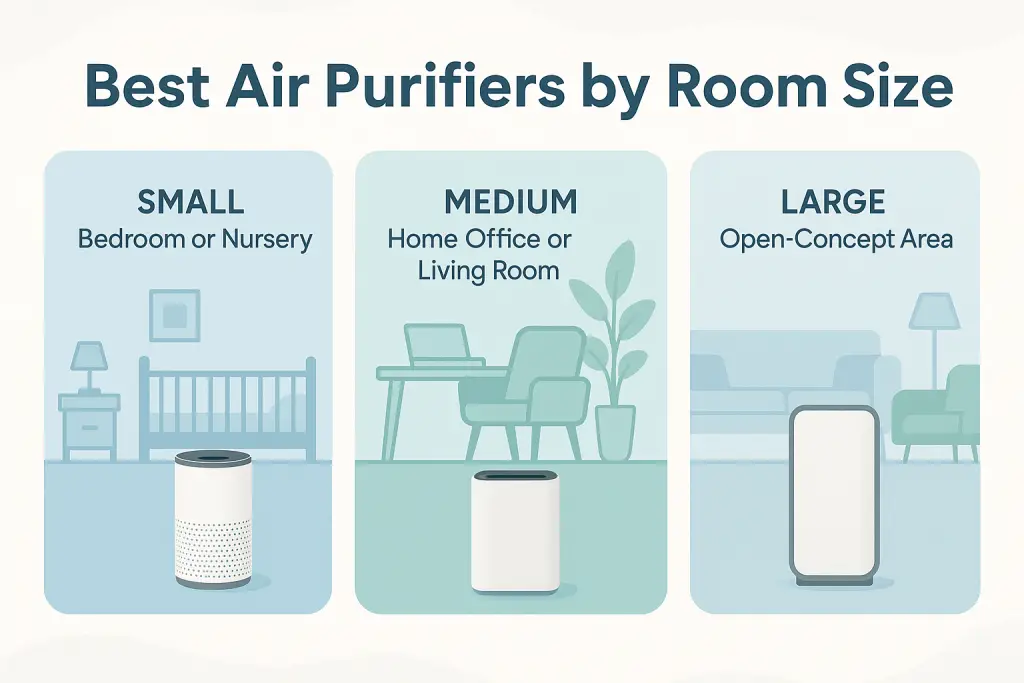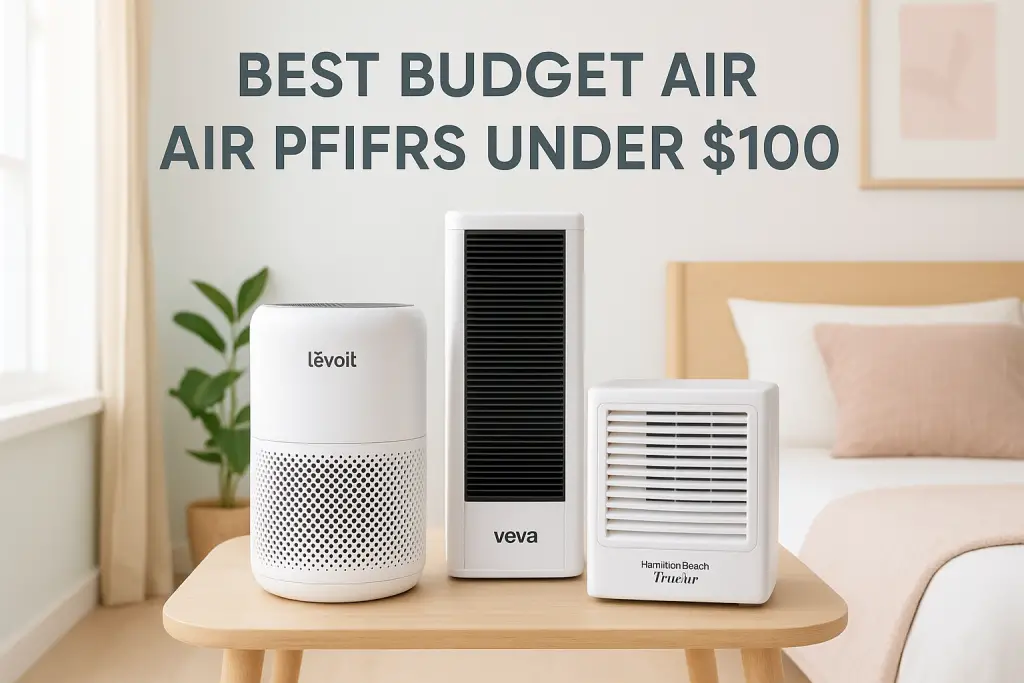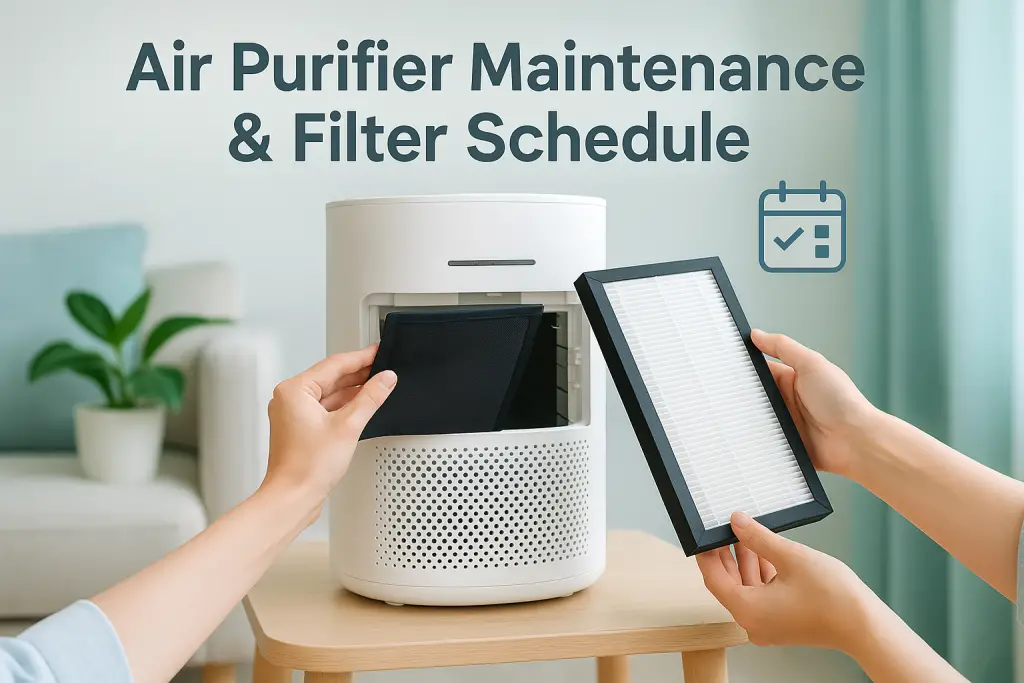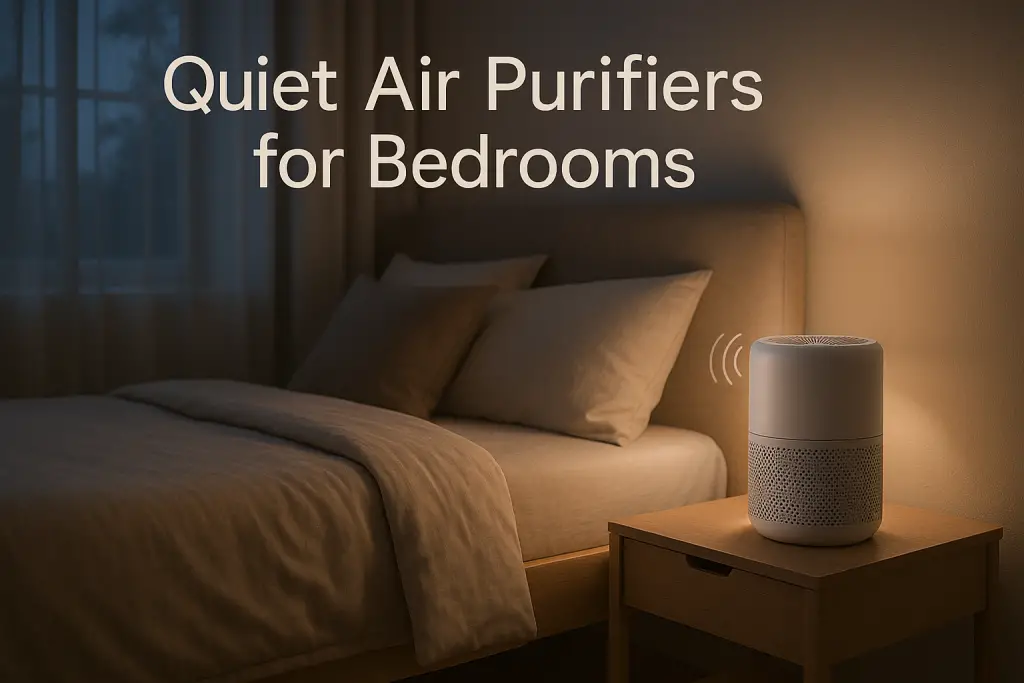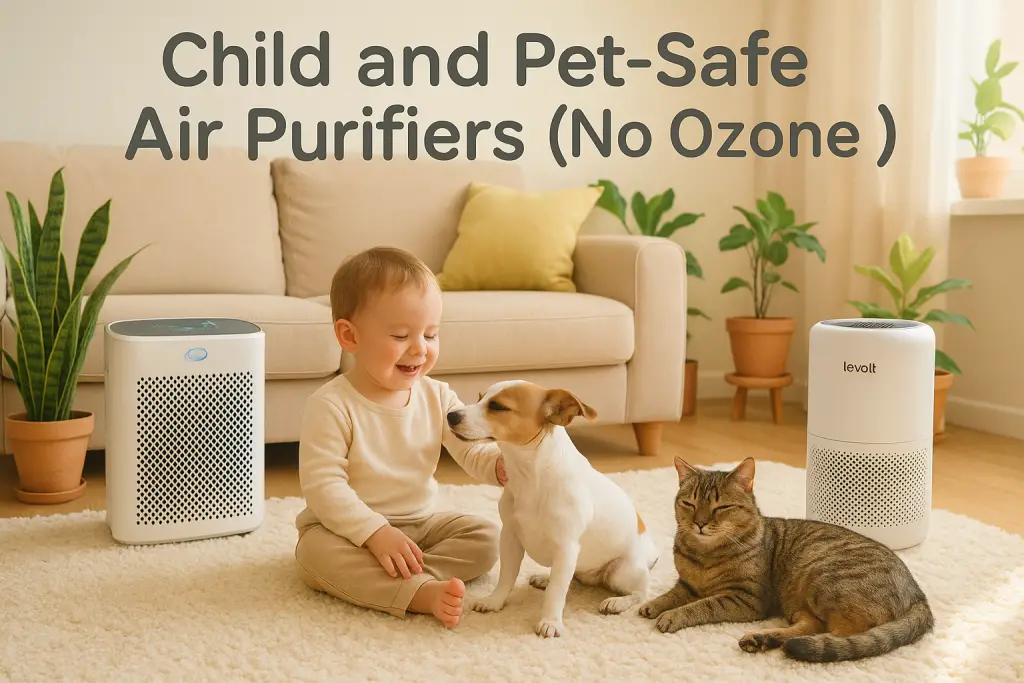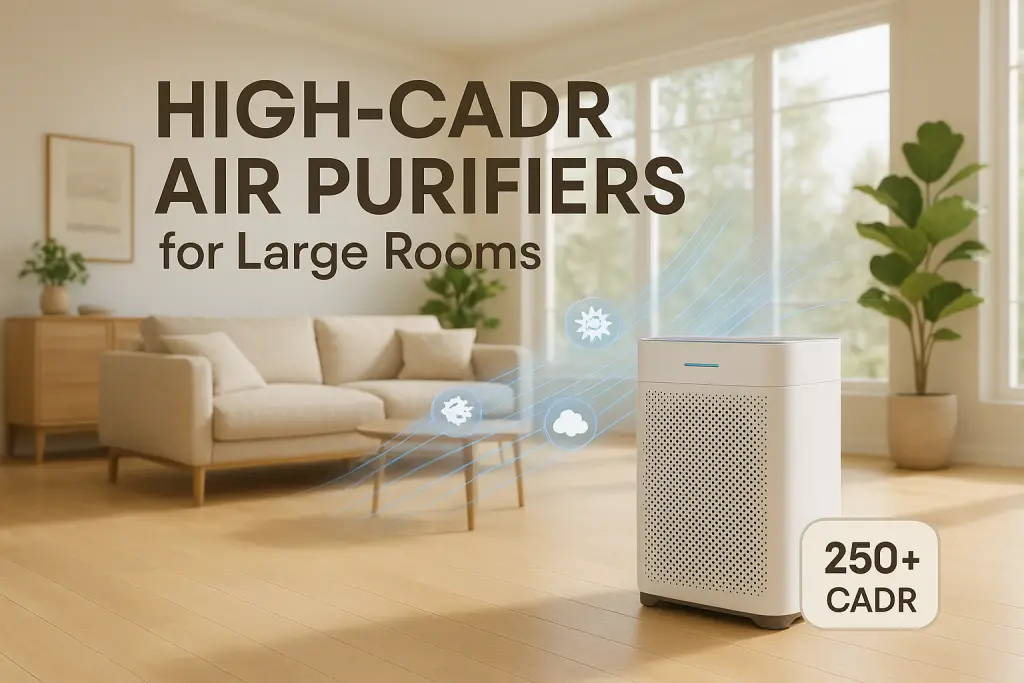Pre-filters play a vital role in air purifier systems by capturing larger airborne particles before they reach the main HEPA filter. Most air purifiers benefit from having a pre-filter, and regular cleaning is essential for optimal performance. This guide covers everything you need to know about pre-filter necessity and maintenance to maximize your air purifier’s effectiveness and lifespan.
What Is an Air Purifier Pre-Filter and How Does It Work?
An air purifier pre-filter is the first line of defense in your air purification system, designed to capture larger particles before they reach the more expensive main filters. Pre-filters typically consist of a mesh or fabric material positioned at the air intake area of your purifier.
Pre-filters work by trapping larger airborne contaminants such as:
- Dust and dirt particles
- Pet hair and dander
- Lint and fabric fibers
- Larger allergens
- Some household debris
Most pre-filters fall into two main categories:
- Washable/Permanent Pre-filters: These reusable filters can be cleaned regularly and replaced back in the unit.
- Disposable Pre-filters: These need replacement after a certain period and cannot be washed.
Common materials used for pre-filters include polypropylene, polyester mesh, and sometimes activated carbon-infused fabrics that provide additional odor filtration. By capturing larger particles first, pre-filters ensure that the main HEPA filter can focus on trapping microscopic pollutants, making your entire air purification system more efficient.
Do I Need a Pre-Filter and How Do I Clean It? 7 Benefits to Consider
While not every air purifier comes with a pre-filter, using one offers significant advantages for both your air quality and wallet. The benefits far outweigh the minimal maintenance required.
- Extended HEPA Filter Life: Pre-filters can extend your main HEPA filter’s lifespan by 30-40%, saving you money on replacements. According to testing data, properly maintained pre-filters can add 3-6 months to your HEPA filter life.
- Cost Savings: While pre-filter cleaning requires some effort, the financial savings are substantial. A $50-100 HEPA filter replacement can be delayed by months with regular pre-filter maintenance, resulting in annual savings of $75-150 for most households.
- Improved Airflow Efficiency: Clean pre-filters prevent airflow restrictions. Studies show units with clean pre-filters maintain up to 90% of their rated CADR (Clean Air Delivery Rate) compared to just 60-70% with clogged filters.
- Better Allergen Control: Pre-filters capture larger allergens before they can break down into smaller particles, providing better overall filtration for allergy and asthma sufferers.
- Energy Efficiency: Air purifiers with clean pre-filters require less power to maintain proper airflow, reducing energy consumption by up to 15%. This translates to lower utility bills and reduced environmental impact.
- Reduced Noise: When air can flow freely through clean filters, the fan doesn’t need to work as hard, resulting in quieter operation. This is particularly important for bedroom units.
- Environmental Impact: By extending the life of your main filters, you reduce waste and the environmental footprint associated with manufacturing and disposing of replacement filters.
Types of Pre-Filters: Which One Do You Need?
Pre-filters come in several varieties, each with specific advantages depending on your air quality concerns and maintenance preferences.
| Pre-Filter Type | Best For | Lifespan | Maintenance |
|---|---|---|---|
| Mesh Washable | Homes with pets, general dust | 1-2 years | Wash every 2-4 weeks |
| Foam Washable | High dust environments | 6-12 months | Wash monthly |
| Carbon Pre-Filters | Odors, light VOCs, smoke | 2-3 months | Typically not washable |
| Electrostatic | Fine dust, allergens | 3-6 months | Vacuum only, no washing |
The right pre-filter depends largely on your specific needs:
- For pet owners: Choose durable mesh washable pre-filters that can capture pet hair effectively
- For allergy sufferers: Consider electrostatic pre-filters that capture more allergens
- For homes with cooking odors or smoke: Carbon-infused pre-filters provide added odor control
When selecting a pre-filter, also consider the specific size and capacity of your air purifier, as this affects how often you’ll need to clean the pre-filter. Larger units serving bigger spaces may require more frequent maintenance.
How to Clean Your Pre-Filter: Step-by-Step Guide
Proper pre-filter cleaning is essential for maintaining your air purifier’s performance and extending the life of your more expensive main filters. Follow these steps for effective cleaning:
- Turn Off and Unplug the Unit: Always disconnect your air purifier from power before any maintenance for safety.
- Remove the Pre-Filter: Open the air intake panel or grill according to your manufacturer’s instructions. Most pre-filters are located at the back or side of the unit and can be removed by releasing tabs or clips.
- Initial Dust Removal: Take the pre-filter outside and gently tap it to remove loose dust and debris. For stubborn dust, use a soft brush to loosen particles.
- Vacuum the Pre-Filter: Using a vacuum cleaner with a brush attachment on low suction setting, gently vacuum both sides of the pre-filter to remove embedded dust.
- Wash If Washable: For washable pre-filters, rinse under lukewarm water (not hot) until water runs clear. For stubborn dirt, use a small amount of mild dish soap, then rinse thoroughly.
- Dry Completely: Allow the pre-filter to air dry completely for 24-48 hours. Never reinstall a damp pre-filter as this can lead to mold growth and reduced efficiency.
- Reinstall Properly: Once completely dry, reinstall following the manufacturer’s instructions, ensuring it sits properly in its designated slot.
Warning: Never use a hairdryer or heating appliance to speed up drying as this can damage or warp the filter material.
Specific Cleaning Instructions by Pre-Filter Type
Different pre-filter materials require specific cleaning approaches to avoid damage while ensuring thorough particle removal.
Woven Polyester/Polypropylene Filters:
- Vacuum first to remove surface debris
- Wash with lukewarm water and mild soap
- Rinse thoroughly until water runs clear
- Shake gently to remove excess water
- Allow to dry completely for 24-48 hours
Foam Pre-Filters:
- Handle carefully to prevent tearing
- Wash by gently squeezing in soapy water
- Rinse thoroughly while squeezing gently
- Press between clean towels to remove excess moisture
- Allow at least 24 hours to dry completely
Carbon-Infused Pre-Filters:
- Most carbon pre-filters are not washable
- Vacuum gently to extend life
- Replace according to manufacturer guidelines
- Some hybrid models allow gentle washing of the non-carbon layer only
Electrostatic Pre-Filters:
- Never wash with water as it damages the electrostatic charge
- Vacuum only using low suction
- Use a soft brush attachment
- Some can be refreshed with indirect sunlight for 1-2 hours
For major brands like Levoit, Honeywell, and Dyson, always check the specific maintenance instructions in your user manual, as some models have unique requirements.
How Often Should You Clean Your Pre-Filter?
The optimal cleaning frequency for your pre-filter depends on several factors including your environment, usage patterns, and air quality challenges. Here’s a general guide to help you determine the right schedule:
| Living Situation | Recommended Cleaning Frequency |
|---|---|
| Standard household, no pets | Every 3-4 weeks |
| Homes with pets | Every 1-2 weeks |
| Allergy sufferers during high pollen season | Weekly |
| Homes in high pollution areas | Every 7-10 days |
| Homes undergoing renovation | Every 3-5 days during construction |
Visual indicators that your pre-filter needs cleaning include:
- Visible dust accumulation on the filter surface
- Reduced airflow from the unit
- Increased fan noise
- Decreased air purification efficiency
- Unit running longer to clean the same space
Regular cleaning of your air purifier components should be part of your routine household maintenance. Consider setting calendar reminders to stay on schedule with your pre-filter cleaning.
Clean vs. Replace: When Is Cleaning Not Enough?
While regular cleaning extends pre-filter life considerably, there comes a point when replacement becomes necessary for optimal air purification.
Signs that your pre-filter needs replacement rather than cleaning:
- Physical damage: Tears, holes, or fraying in the material
- Permanent staining: Discoloration that doesn’t wash out
- Structural deformation: Warping or loss of shape that affects fit
- Persistent odors: Smells that remain after thorough cleaning
- Reduced efficiency: Continued airflow problems after cleaning
For washable pre-filters, expect a lifespan of approximately:
- Mesh filters: 1-2 years with regular cleaning
- Foam filters: 6-12 months with proper maintenance
- Combination filters: Varies by usage, typically 6-18 months
When considering replacement versus continued cleaning, factor in both the cost of a new pre-filter (typically $10-30) and the potential reduction in main filter life if you continue using a compromised pre-filter.
Troubleshooting Common Pre-Filter Problems
Even with regular maintenance, you may encounter specific issues with your pre-filter that require targeted solutions.
Problem: Reduced airflow after cleaning
Solution: Ensure the pre-filter is completely dry before reinstalling. Check for proper installation and make sure it’s not blocking the air intake.
Problem: Persistent odors despite cleaning
Solution: Standard pre-filters don’t remove odors effectively. Consider adding an activated carbon filter or replacing with a carbon-infused pre-filter.
Problem: Discoloration that won’t wash out
Solution: Some staining is normal and doesn’t affect function. Replace only if airflow is compromised.
Problem: Damage during cleaning
Solution: If tears or holes develop, replace immediately as damaged filters allow particles to bypass filtration.
Problem: Mold or mildew development
Solution: Replace the filter immediately and ensure complete drying after future cleanings. Consider running your purifier in a less humid environment or using a dehumidifier.
To distinguish between pre-filter and main filter problems, try running the unit briefly without the pre-filter (if your manufacturer allows this). If performance improves, the pre-filter was likely the issue. If problems persist, your main filter may need attention.
Special Situations: Pre-Filter Considerations for Specific Needs
Certain living situations and health concerns require special attention to pre-filter selection and maintenance.
For Allergy and Asthma Sufferers:
Clean pre-filters weekly during high pollen seasons. Consider using electrostatic pre-filters that capture smaller allergens. The Asthma and Allergy Foundation of America recommends using purifiers with multiple filtration stages for best results.
For Pet Owners:
Select durable mesh pre-filters designed to capture pet hair. Clean at least weekly in multi-pet households. Consider using a soft brush to remove embedded pet hair before washing. Place your air purifier in areas where pets spend the most time.
For Homes with Children:
Choose pre-filters with secure attachments that can’t be easily removed by curious hands. Maintain regular cleaning schedules as children can introduce more dust and debris.
For Urban Environments:
In high pollution areas, consider a dual pre-filter approach with both a washable mesh filter for large particles and a disposable filter layer for finer pollution. Clean or replace more frequently during poor air quality days.
For Wildfire Season:
During periods of smoke exposure, pre-filters will collect more particles rapidly. Check daily and clean as soon as visible accumulation appears. Consider temporary upgrades to carbon pre-filters to help with smoke odors.
For Elderly or Physically Limited Users:
Select models with easy-access pre-filters that don’t require tools or complex disassembly. Consider purifiers with filter replacement indicators to eliminate guesswork.
Pre-Filter Innovations and Future Trends
The air purification industry continues to evolve, with several notable innovations in pre-filter technology worth considering.
Recent developments include:
- Antimicrobial treatments: Pre-filters with built-in antimicrobial properties prevent bacterial and mold growth between cleanings
- Self-cleaning technologies: Some premium models now incorporate automatic pre-filter cleaning systems that use vibration to shake off dust into a collection tray
- Smart maintenance tracking: Advanced air purifiers with auto modes now monitor air quality and filter condition, providing mobile alerts when cleaning is needed
- Eco-friendly materials: Biodegradable pre-filter options made from sustainable materials are entering the market
- Multi-layered pre-filtration: Systems with graduated pre-filter layers to capture different particle sizes more efficiently
Industry experts predict future developments will include washable pre-filters with even longer lifespans and improved dust-repelling properties that extend cleaning intervals. Research is also underway on pre-filters that change color as they collect particulates, providing visual indication of cleaning needs.
Conclusion: Maximizing Your Air Purifier’s Performance Through Pre-Filter Maintenance
Proper pre-filter maintenance is one of the most impactful ways to ensure your air purifier delivers clean air efficiently while extending the life of your investment. Regular cleaning not only saves money by extending the life of expensive main filters but also maintains optimal performance.
Remember these key takeaways:
- Most air purifiers benefit significantly from having a pre-filter
- Clean your pre-filter every 2-4 weeks for optimal performance, more frequently in challenging environments
- Follow the specific cleaning method appropriate for your pre-filter type
- Allow complete drying before reinstallation
- Replace pre-filters showing signs of damage or permanent clogging
By implementing a regular pre-filter maintenance routine, you’ll enjoy cleaner air, lower operating costs, and a longer-lasting air purification system. Your lungs and wallet will both thank you.
| Photo | Air Purifier Model | Best for | Price |
|---|---|---|---|

|
WINIX A231 Air Purifier | Asthma & Indoor Pollution | Check Price On Amazon |

|
Rabbit Air, A3 SPA-1000N Air Purifier | Pet Dander & Odors | Check Price On Amazon |

|
LEVOIT Air Purifier | Best Overall | Check Price On Amazon |

|
GermGuardian Air Purifier | Cigarette & Cooking Smoke | Check Price On Amazon |

|
Coway Airmega Air Purifier | New-borns | Check Price On Amazon |

|
BLUEAIR Air Purifier | Germ & Virus Control | Check Price On Amazon |
